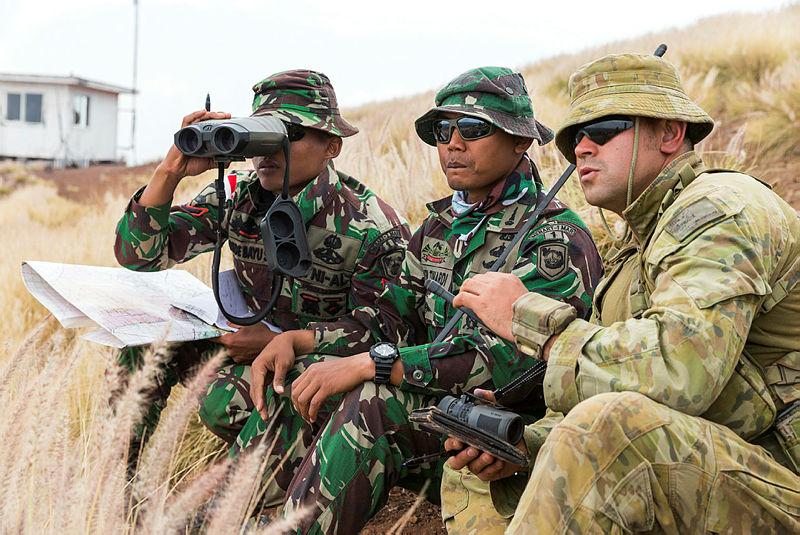
In late August, Indonesia and Australia signed a new comprehensive strategic partnership agreement during Prime Minister Scott Morrison’s visit to Jakarta. The document provides a new long-term framework for the bilateral relationship as part of a broader Indo-Pacific vision. Defence cooperation is a central component of that vision.
The relationship between the Indonesian defence force (TNI) and the Australian defence force (ADF) has been on the upswing. In early September, the Indonesian navy participated in Exercise Kakadu, Australia’s largest maritime exercise involving 27 countries. And in 2016, the Indonesian army held a joint training exercise in Darwin as part of Exercise Wirra Jaya, which is now an annual event. It was the first time an Indonesian unit had trained on Australian soil since 1995.
Back in July, senior leaders of the armed forces agreed to hold more joint TNI–ADF exercises and training in 2019 and 2020.
Such developments reinforce the common refrain in the Australian strategic community that Indonesia is the country’s ‘most important’ regional security partner.
This notion goes back to the 1995 Agreement to Maintain Security, the first defence agreement between the two countries. Although the pact was scrapped after the 1999 Australian-led UN intervention in East Timor, the 2006 Lombok Treaty revived the narrative.
The 2009 defence white paper noted that ‘Australia’s relationship with Indonesia remains our most important defence relationship in the immediate region’. Despite the bilateral crises and hiccups over the past decade, that view has persisted among Australian officials and analysts. The 2016 white paper stated that a ‘strong and productive relationship with Indonesia is critical to Australia’s national security’. Most recently, one former senior Department of Defence official argued that Indonesia remains ‘the country of most importance to Australia and our long-term security’.
But this story of Indonesia’s importance is inaccurate.
First, Indonesia has never been the largest recipient of funding from Australia’s defence cooperation program (DCP). That position has been held by Papua New Guinea since the 1970s. Indonesia wasn’t even always the highest DCP recipient among Southeast Asian nations.
After the Lombok Treaty, DCP funding to Indonesia averaged around A$4.4 million per year. But compared to other DCP recipients over the past two decades, Indonesia ranked second-highest only twice (2006–07 and 2016–17). Most often, Indonesia ranked third (12 years), fourth (two years), fifth (three years) or sixth (once, in 2000–01).
The DCP may not be the only form of defence engagement, but historically it constitutes the bulk of it, and the available DCP data provides a powerful measure that is difficult to ignore.
Second, Indonesia has never been Australia’s most important training partner. That title belongs to the United States.
Bilateral exercises with Indonesia amount to only around 8% (37 out of 449) of all ADF bilateral exercises between 1997 and 2015. The United States, New Zealand, Thailand, Papua New Guinea and Malaysia have had more exercises with Australia than Indonesia has in that period.
Third, Indonesia and Australia don’t have a well-developed and institutionalised arrangement for defence technological cooperation or defence industrial collaboration.
Policymakers only recently explored the possibility of industrial collaboration. In late 2016, Australia and Indonesia agreed to work together on developing an armoured vehicle based on the design of Thales Australia’s Bushmaster.
But such efforts pale in comparison to the low level of Indonesia–Australia technological cooperation. From 1969 to 2016, for example, Australia sent patrol boats, fighter aircraft, and light transport and maritime patrol aircraft to Indonesia. Most of the vessels, however, were provided during the Cold War and are by now around 40 years old.
Indeed, according to a survey of Indonesian recipients of Australian education and training programs, the lack of technological cooperation remains one of the big stumbling blocks in defence collaboration.
Taken together, these indicators suggest that Australia has more important security partners than Indonesia. Instead, Indonesia’s significance to Australia’s strategic geography and the historical volatility of bilateral ties seem to have driven the narrative.
In any case, to ensure that the broad vision outlined in the new partnership agreement can materialise, both Jakarta and Canberra need to stabilise and institutionalise bilateral defence ties. One of the first steps needs to be to stop saying that Indonesia is Australia’s most important security partner. After all, that label is not only inaccurate, but also raises unnecessary and unrealistic expectations of what defence cooperation can accomplish.